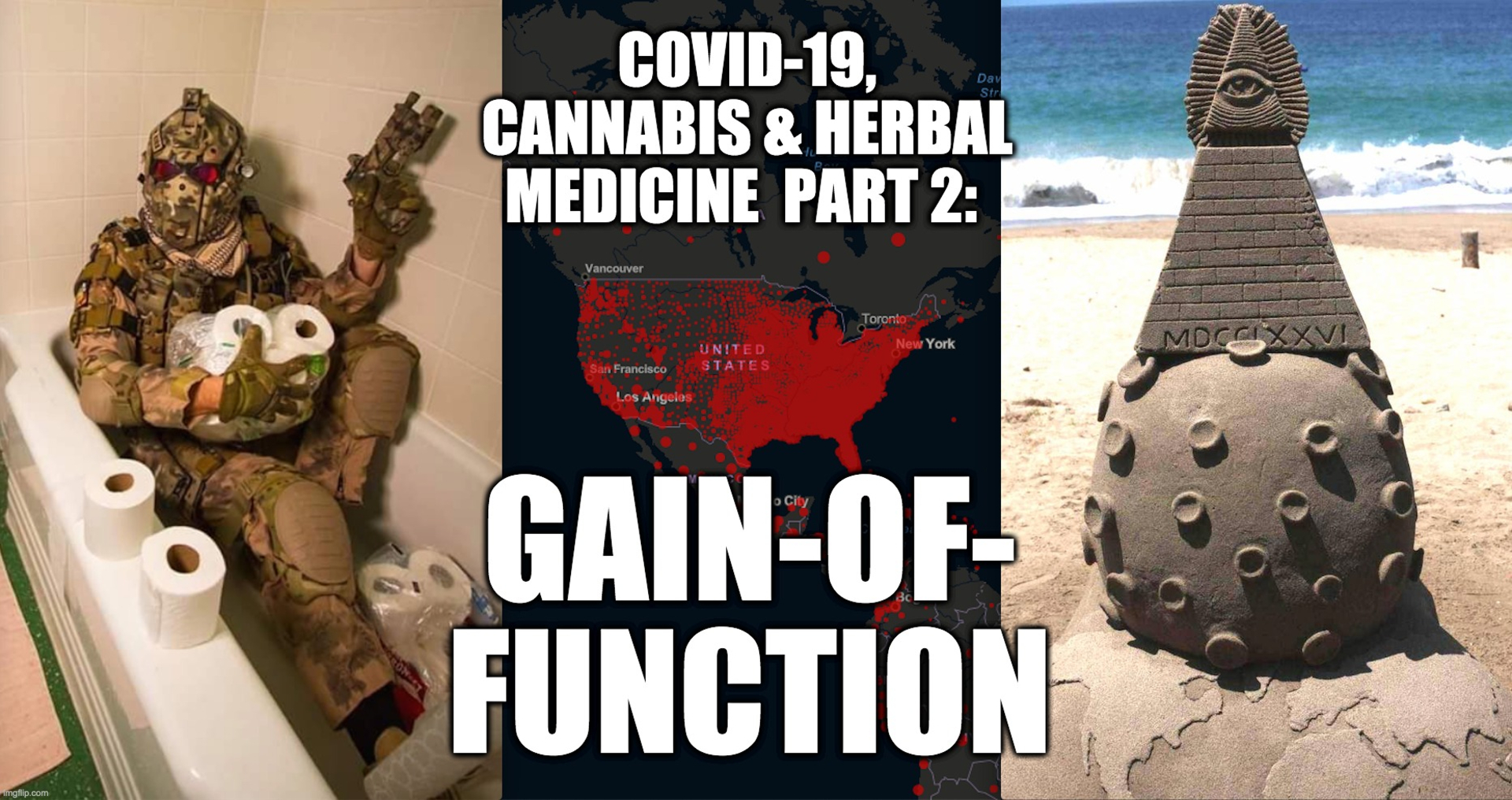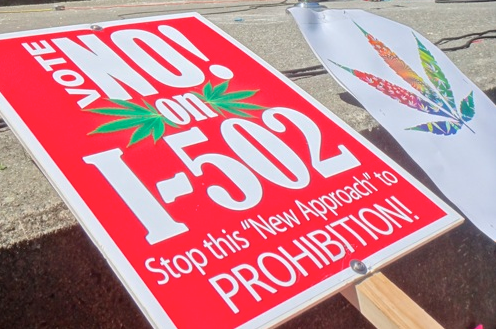Caffeine or cannabis – which drug is more dangerous?
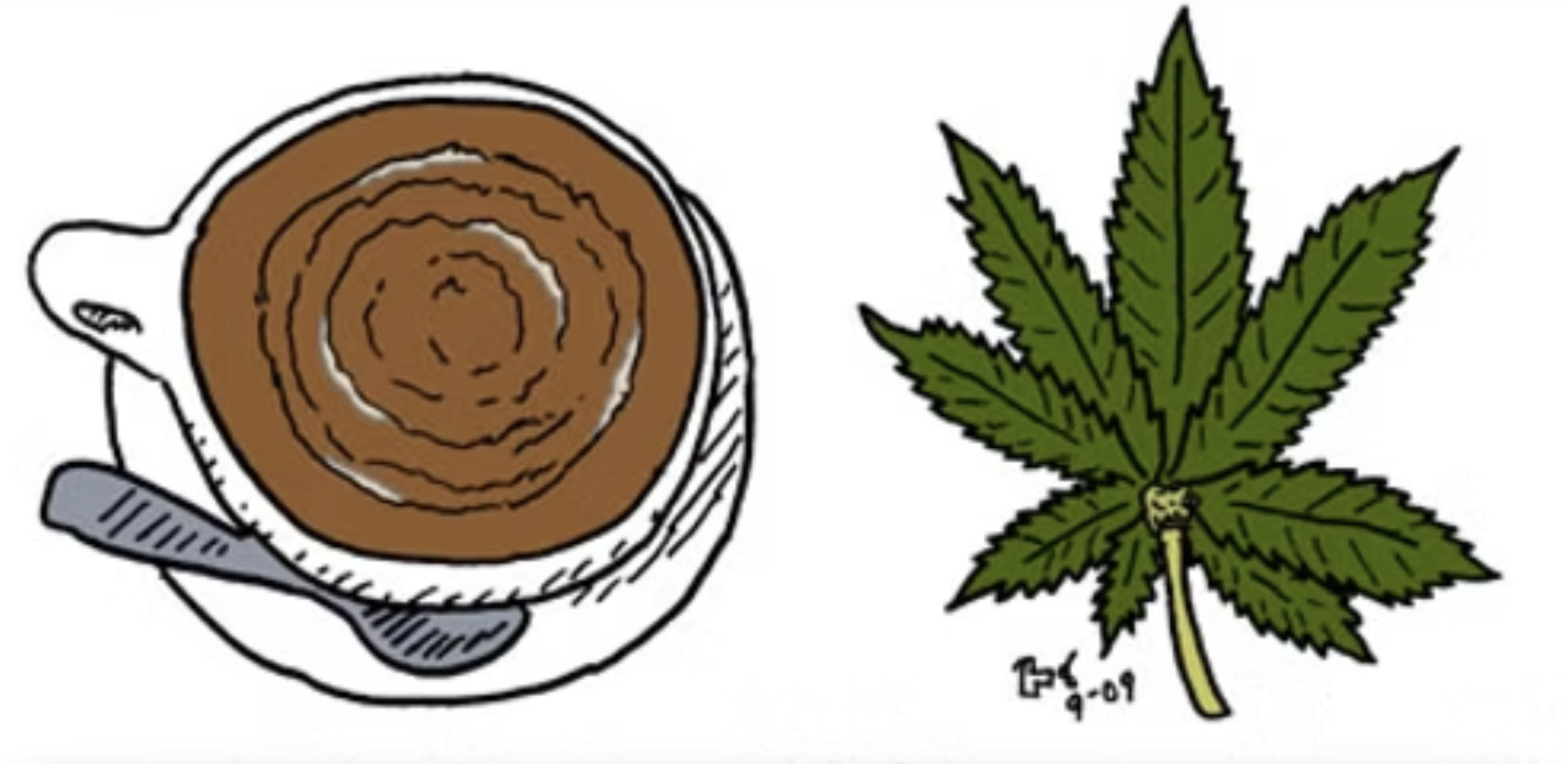
Caffeine or cannabis –which drug is more dangerous?
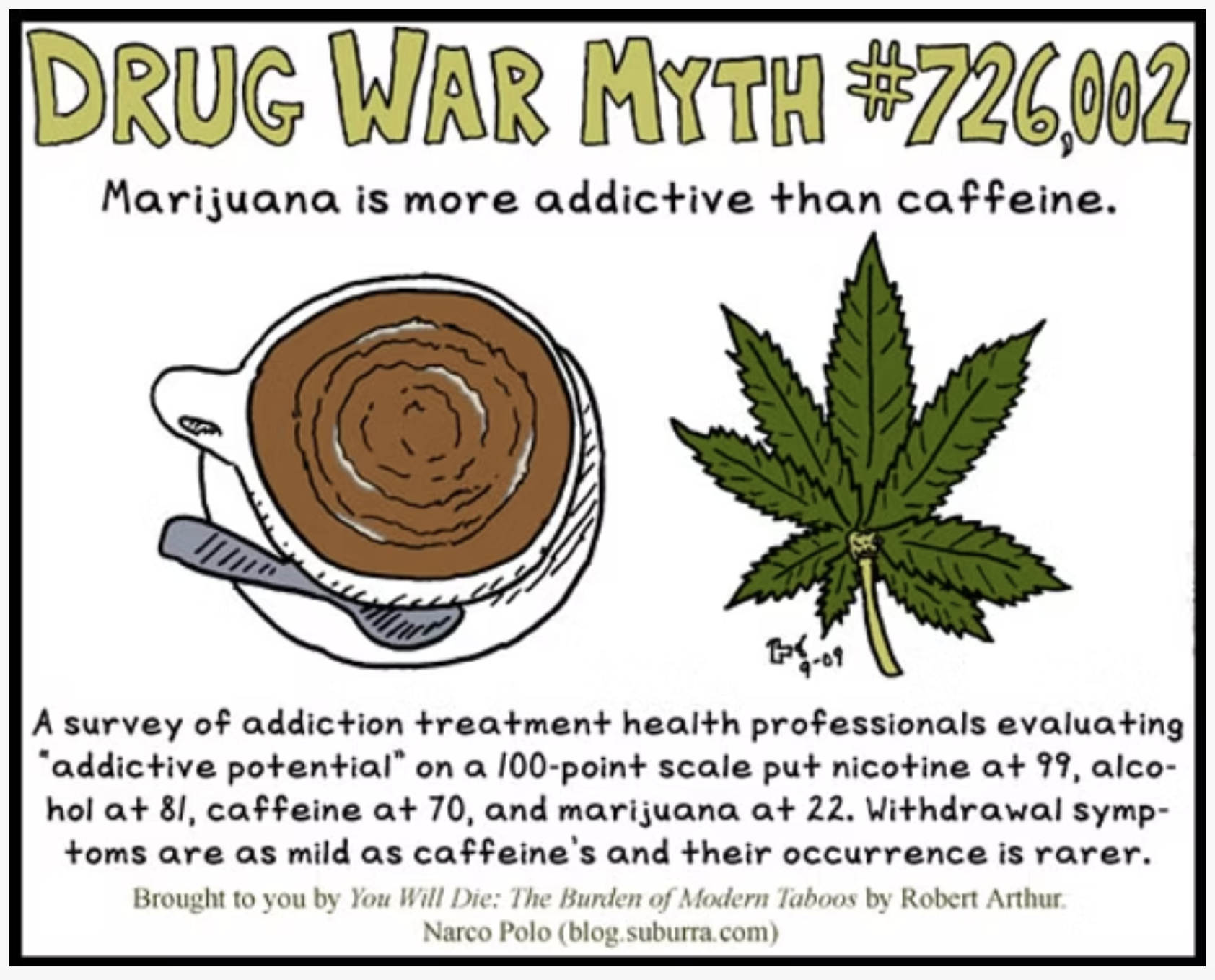
Image from https://www.starbuds.us/single-post/2016/12/01/cannabis-vs-caffeine
THE SLIPPERY SLOPE…
“…it is sufficient in this regard for Parliament to have a reasonable basis for concluding that harm (to society) will result and this requirement does not demand actual proof of harm.”
–R. v. Butler, 1992, Supreme Court of Canada case about “obscene” pornography
So, what is the minimum level of harm to society necessary before the government can criminalize an activity ? Where do we draw the line? How much freedom is too much for this world’s people at the dawn of a new millennium? If we draw the line as low as cannabis smoking – anything more risky than toking some pot and the government has the right to prohibit it – then earth will become a world of slaves and small children.
NEARLY EVERYTHING IS MORE RISKY THAN CANNABIS SMOKING!!!
Horseback riding, canoeing, driving down the highway, breathing city air, watching too much TV, missing sleep, eating lots of red meat or even drinking three or four cups of coffee every day – each of these common activities may one day be viewed as posing an “unacceptable” risk level by some well-meaning, health conscious politician or judge.
Take coffee for example. Caffeine is the best drug to compare with cannabis, considering they are both low-risk stimulants.
OVERDOSE DEATHS: CAFFEINE HAS MORE
Caffeine, six recorded deaths in the United States. (Maisto, Galizio, Connors, “Drug Use and Misuse”, Harcourt Brace Jovanovich College Publishers, 1991, p.162)
Cannabis: zero – worldwide. (Testimony of Dr. Kalant, Jan. 30, 1997, R. v. Clay, see also Robert Clarke and David Pate, “Medical Marijuana” Journal of the International Hemp Association, Volume 1, Number 1, 1994, p.9)
One would each have to orally ingest about a pound and a half of high-grade bud (Clarke & Pate, Journal of the International Hemp Association,, Vol. 1, #1, 1994, p.10) or smoke over 15 pounds within 15 minutes (Ex-Drug Enforcement Agency Administrative Law Judge Francis L. Young, 1988, taken from “Marijuana – Not Guilty As Charged”, D.R. Ford, Good Press, 1997, p. 238) to even risk death from too much cannabis, but it would only take you 50 tiny 200mg “Wake-up” caffeine pills to O.D. on caffeine, or 40 cups of coffee (Richard J. Gilbert Ph.D., “Caffeine – The Most Popular Stimulant”, from the Encyclopedia of Psychoactive Drugs, 1986, Burke Publishing Company Limited, p.94), maybe 20 double-espressos – even less for a child.
OVERUSE DEATHS: CAFFEINE HAS MORE
Caffeine kills 1000 to 10000 people every year in the United States, from “stress, ulcers and triggering irregular heartbeats”. (U.S. Bureau of Mortality Statistics and the National Institute on Drug Abuse, 1988, taken from Jack Herer, The Emperor Wears No Cloths, HEMP Publishing, 1993-94, back cover.)
Again cannabis is zero. (See information above)
WITHDRAWAL SYMPTOMS: CAFFEINE’S ARE MORE SERIOUS
Caffeine offers the famous headache. (Richard J. Gilbert Ph.D., “Caffeine – The Most Popular Stimulant”, from the Encyclopedia of Psychoactive Drugs, 1986, Burke Publishing Company Limited, pp. 93, 99, 100)
With cannabis; “If people experience withdrawal symptoms at all, they are remarkably mild.” (Drs. Zimmer & Morgan, Marijuana Myths-Marijuana Facts, 1997, p. 26:
ACUTE EFFECTS: CAFFEINE’S EFFECTS ARE MORE SERIOUS
Acute effects are immediate health problems that may result from misuse – including impairment.
Caffeine “significantly increases the blood pressure in subjects who have been without the drug for some days”, causes “palpitations” in those who have had such heart conditions in the past, can lead to “digestive upset” and “ulcers”. Larger doses can lead to “hyperventilation”, “rapid heartbeat”, “convulsions”, “rapid, uncoordinated twitching of the heart”. (Richard J. Gilbert Ph.D., “Caffeine – The Most Popular Stimulant”, from the Encyclopedia of Psychoactive Drugs, 1986, Burke Publishing Company Limited, pp. 86-95)
Cannabis “acute toxicity is low compared with that of any other drugs” (1977 Commission of the Australian Government, from Zimmer and Morgan, Marijuana Myths, Marijuana Facts, pp pre-1 and 150)
Cognitive impairment, psycho-motor impairment, anxiety, dysphoria, panic and paranoia, chronic bronchitis, and a “dependence syndrome” (1994 Australian National Drug Strategy Report)
LONG-TERM EFFECTS: CAFFEINE EFFECTS ARE MORE SERIOUS
Every other British Adult may be dependent on caffeine and use it at least in part to ward off withdrawal symptoms. And about 1 in 5 adults may regularly use enough caffeine to cause physical harm, notably heart disease, bladder cancer in males and behavioral disorders. (Richard J. Gilbert Ph.D., “Caffeine – The Most Popular Stimulant”, from the Encyclopedia of Psychoactive Drugs, 1986, Burke Publishing Company Limited, p. 123)
With cannabis; “There are no significant problems concerns with respect to the low/occasional/moderate adult heavy user” “the major probable adverse effects on chronic heavy cannabis users appear to be: “respiratory disease” such as “chronic bronchitis”, a “dependence syndrome” and “Subtle forms of cognitive impairment.” (1994 Australian National Drug Strategy Report) The author would add that this is most likely only from misuse, not proper chronic heavy cannabis use.
DIRECT COMPARISONS – DEPENDENCE, WITHDRAWAL, TOLERANCE
In 1994, Dr. Jack E Henningfield of the National Institute on Drug Abuse and Dr. Neal L. Benowitz of the University of California ranked six substances based on five problem areas. The substances were nicotine, heroin, cocaine, alcohol, caffeine and marijuana. The problem areas were withdrawal, reinforcement, tolerance, dependence, and intoxication. Dependence was defined as;
How difficult it is for the user to quit, the relapse rate, the percentage of
people who eventually become dependent, the rating users give their own
need for the substance and the degree to which the substance will be used in
the face of evidence that it causes harm.
Cannabis was given the lowest dependence, withdrawal and tolerance rating of all six drugs including caffeine. (New York Times, August 2nd, 1994, B6)
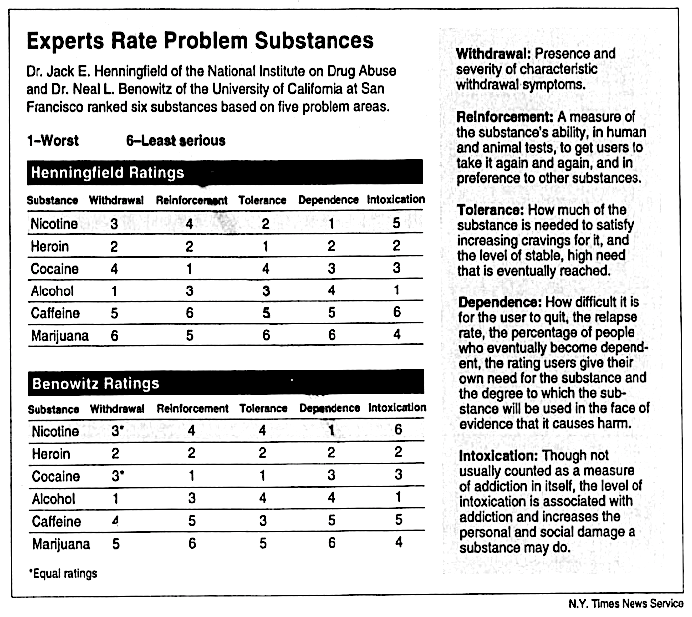
Image from “Experts Rate Problem Substances,” Daily World, Opelousas, Louisiana, August 9th, 1994, p. 5
CONCLUSION: CAFFEINE PROHIBITION IS ON THE WAY!
The facts seem to indicate that caffeine does cause harm – far more, in fact, “than was first believed”. It “provokes erratic behavior in the user or abusive user”. “Accidents” involving “complex machinery” could happen. A “vulnerable person” such as an adolescent, may become a chronic user and hurt themselves from the act of drinking a few cups and then popping a few wake-up pills.
And as we all know from pot, the freedom to use caffeine “does not constitute a matter of fundamental personal importance”. “It is for Parliament to determine what level of risk is acceptable and what level of risk requires action”. All these arguments are taken from the Clay, Caine and Malmo-Levine court cases – all arguments used against cannabis relegalization.
THE LESSON FROM ALCOHOL PROHITION: DON’T CRIMINALIZE RISK!
There is a lesson to be learned from alcohol prohibition. The lesson is that prohibition of not-directly-harmful-to-others activities always means Al Capone, and Al Capone always carries a price higher than the costs of the education and regulation of the pleasurable activity one wishes to, at first, prohibit. It was summed up nicely in Frank W. Anderson’s “The Rum Runners”, where he concluded the book with the following wisdom:
It is true that the occasional “town drunk” is seen in Calgary, Lethbridge and
Edmonton, but this seems a small price to pay in contrast with the tension, the
ever-present threat of violence, and the indignity that the average citizen was
once forced to endure to obtain liquor.
CANADA – LEADING THE WAY THEN AND NOW
Canada was the first one in North America to learn the lessons of alcohol prohibition. The author believes it is Canada’s role to be the first on the continent to apply those lessons to cannabis prohibition. Giving our representatives the power to decide what is too risky for us to attempt is the wrong place to draw the line.
The line should be drawn at harm to others. Clear, significant, easy-to-demonstrate harm. The only “action” that our leaders have a legitimate role in when it comes to risk to self, is education and regulation. The police make lousy teachers and even worse doctors.
The anti-pot politicians keep speaking about an “increase” in cannabis use after relegalization, as if that’s such a bad thing. The good news behind an increase in cannabis use may not only be the savings to our healthcare system from a decrease in alcohol, tobacco and pill consumption, but additional savings from a decrease in caffeine consumption.
David Malmo-Levine, Cannabis Consultant, Spring 2002


